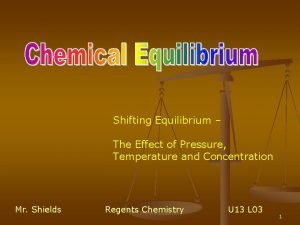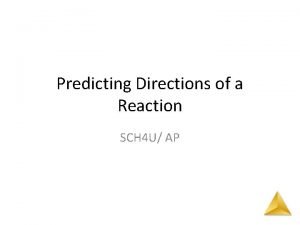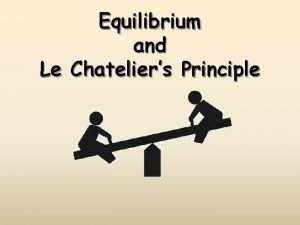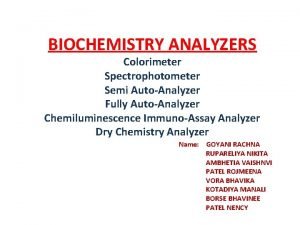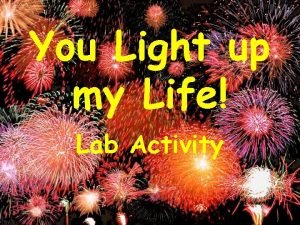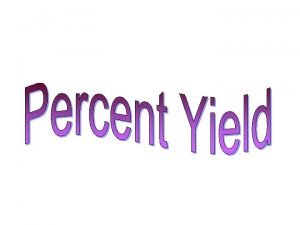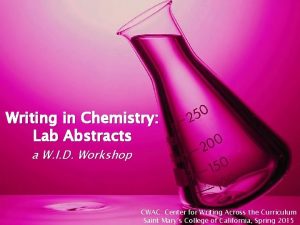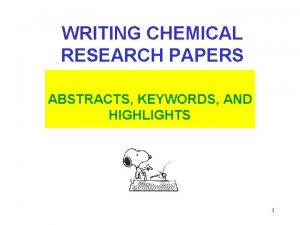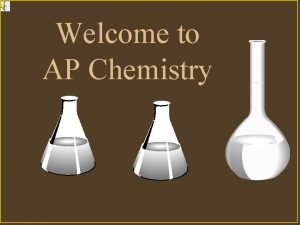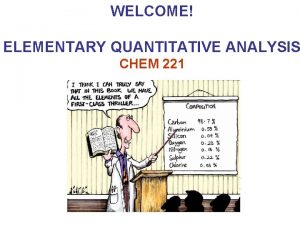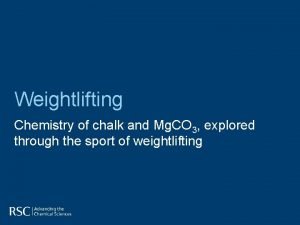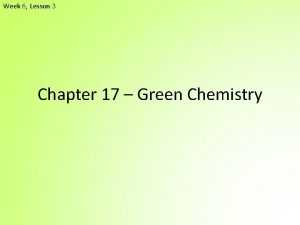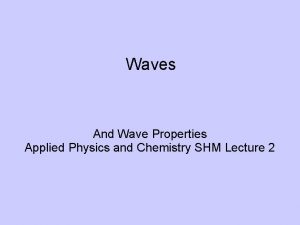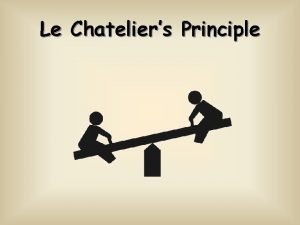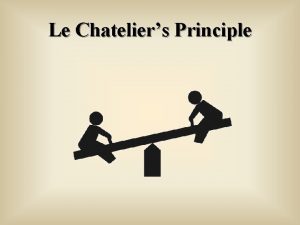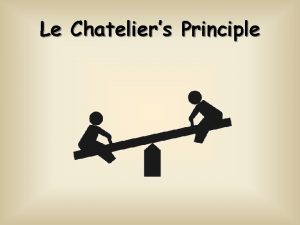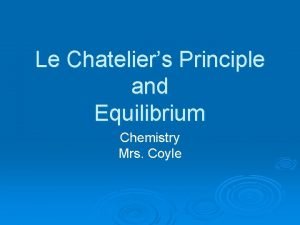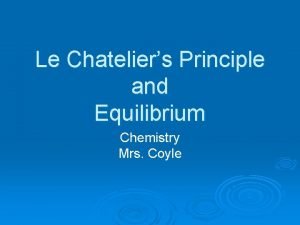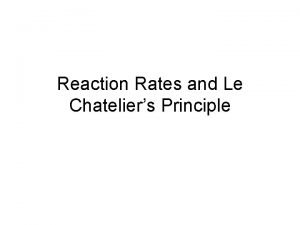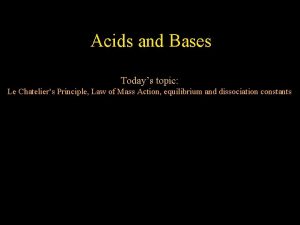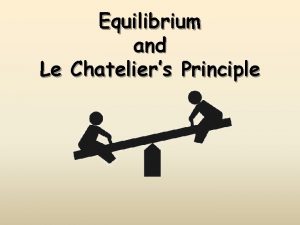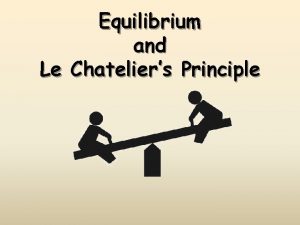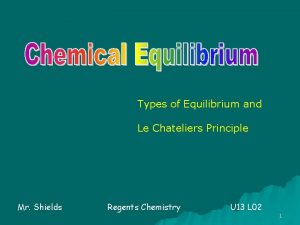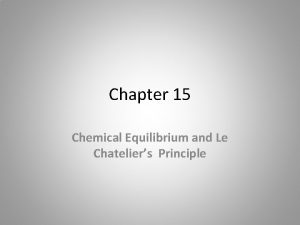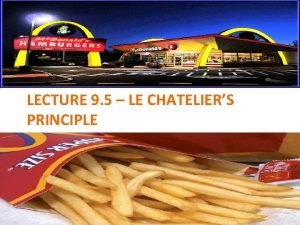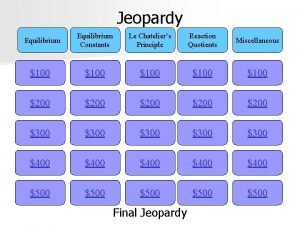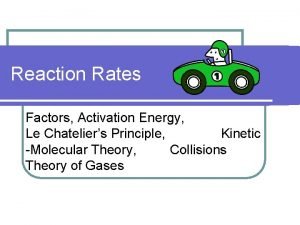Le Chateliers Principle AP Chemistry Le Chateliers Principle


















- Slides: 18

Le Chatelier’s Principle AP Chemistry

Le Chatelier’s Principle If a stress is applied to a system at equilibrium, the system will change to relieve that stress and re – establish equilibrium It is like the “undo” button on your computer!

Factors that Affect Equilibrium • Concentration • Temperature • Pressure – For gaseous systems only! • The presence of a catalyst

Concentration Changes • Add more reactant Shift to products • Remove reactants Shift to reactants • Add more product Shift to reactants • Remove products Shift to products

Reaction Quotient • The reaction quotient for an equilibrium system is the same as the equilibrium expression, but the concentrations are NOT at equilibrium! N 2 O 4(g) 2 NO 2(g) Q = [NO 2]2 [N 2 O 4]

Changes in Concentration Changes in concentration are best understood in terms of what would happen to “Q” if the concentrations were changed. N 2 O 4(g) 2 NO 2(g) • Q = Keq at equilibrium Q = [NO 2]2 [N 2 O 4] • If Q< K then there are too many reactants, the reaction will shift in the forward direction (the products) • If Q>K then there are too many products, the reaction will shift to the reactants.

Temperature Changes Exothermic Reactions • Consider heat as a product in exothermic reactions. A + B = AB + Heat – Add heat Shift to reactants – Remove heat Shift to products

Temperature Changes Endothermic Reactions • Consider heat as a reactant in endothermic reactions. A + B + heat = AB – Add heat Shift to products – Remove heat Shift to reactants

Pressure Changes • Only affects equilibrium systems with unequal moles of gaseous reactants and products.

N 2(g) + 3 H 2(g) = 2 NH 3(g) • Increase Pressure –Stress of pressure is reduced by reducing the number of gas molecules in the container. . .

N 2(g) + 3 H 2(g) = 2 NH 3(g) • There are 4 molecules of reactants vs. 2 molecules of products. –Thus, the reaction shifts to the product ammonia.

PCl 5(g) = PCl 3(g) + Cl 2(g) • Decrease Pressure – Stress of decreased pressure is reduced by increasing the number of gas molecules in the container.

PCl 5(g) = PCl 3(g) + Cl 2(g) • There are two product gas molecules vs. one reactant gas molecule. • Thus, the reaction shifts to the products.

Presence of a Catalyst • A Catalyst lowers the activation energy and increases the reaction rate. • It will lower the forward and reverse reaction rates, • Therefore, a catalyst has NO EFFECT on a system at equilibrium! • It just gets you to equilibrium faster!

Presence of an Inert Substance • An inert substance is a substance that is notreactive with any species in the equilibrium system. • These will not affect the equilibrium system. • If the substance does react with a species at equilibrium, then there will be a shift!

• Given: • S 8(g) + 12 O 2(g) 8 SO 3(g) + 808 kcals • What will happen when …… • Oxygen gas is added? Shifts to prodcuts • The reaction vessel is cooled? Shifts to Products – to replace heat • The size of the container is increased? V increases, Pressure decreases, shifts to more particles – to reactants! • Sulfur trioxide is removed? Shift to products to replace it! • A catalyst is added to make it faster? No change!

Given 2 Na. HCO 3(s) Na 2 CO 3 (s) + H 2 O (g) + CO 2(g) • What will happen when. . . . • Carbon dioxide was removed? Shift to products – to replace it • Sodium carbonate was added? No Change – solids to not affect equilibrium • Sodium bicarbonate was removed? No Change

• Given Ca 5(PO 4)3 OH(s) 5 Ca 2+(aq) + 3 PO 43 -(aq) + OH- (aq) • What will happen when. . . • Calcium ions are added? Shift to the reactants • Na. OH is added? Adding OH- , shifts to reactants • 1 M HCl is added? H+ + OH- H 2 O (removes OH-, shifts to products) • Na 3 PO 4(aq) is added? Adds PO 43 - ions, shifts to reactants
 Le chatelier's principle temperature
Le chatelier's principle temperature Le chatliers principle
Le chatliers principle Le chateliers principle
Le chateliers principle Ib organic chemistry
Ib organic chemistry Inorganic chemistry vs organic chemistry
Inorganic chemistry vs organic chemistry Dry chemistry advantages and disadvantages
Dry chemistry advantages and disadvantages How to calculate percent yield
How to calculate percent yield You light up my life chemistry lab answer key
You light up my life chemistry lab answer key How to calculate the theoretical yield
How to calculate the theoretical yield Criss cross chemistry
Criss cross chemistry Abstract chemistry example
Abstract chemistry example Abstract and keywords example
Abstract and keywords example Chemistry parody songs
Chemistry parody songs Etch
Etch Significant figures ap chemistry
Significant figures ap chemistry Analytical chemistry definition
Analytical chemistry definition Is chalk natural or manmade
Is chalk natural or manmade Atom economy in green chemistry
Atom economy in green chemistry V=fλ example
V=fλ example
